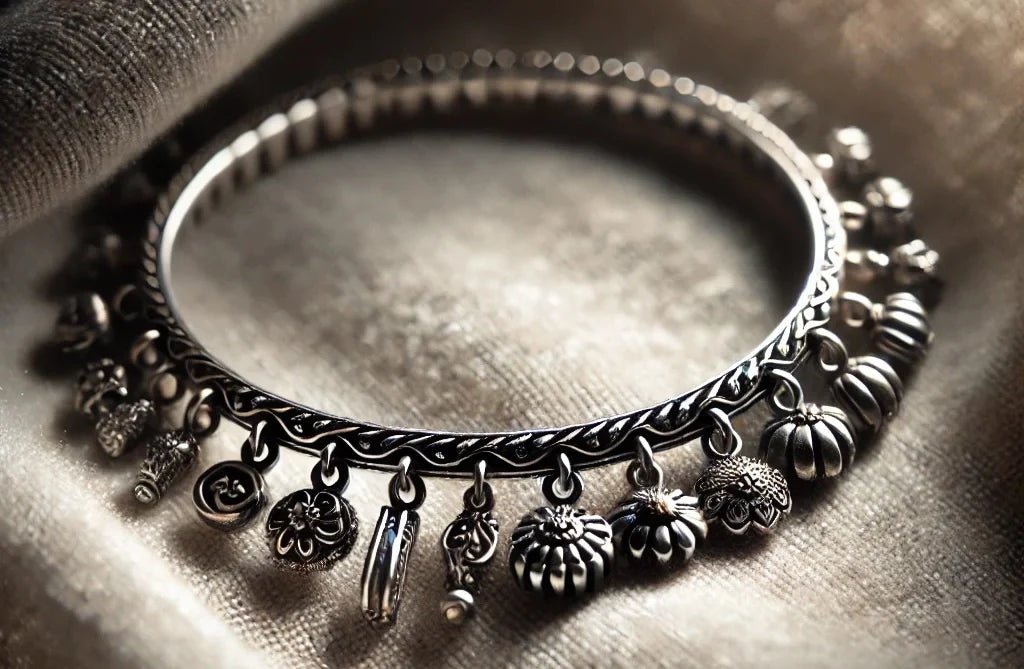
Why Does Silver Tarnish? Unveiling the Mysteries of Silver Discoloration
Share
Silver's shimmering beauty makes it a favorite for jewelry, ornaments, and home décor. But over time, that stunning shine can fade, replaced by a dull gray or yellowish tint. Ever wondered "why does silver tarnish"? This guide uncovers the science behind silver discoloration, explores what causes it, and shares easy ways to prevent and fix it. Whether you’ve got a cherished necklace or a vintage silver tray, understanding tarnish keeps your treasures gleaming.
New to precious metals? Dive into The Magic of Precious Metals: Silver vs. Gold for a fun comparison. Let’s unravel the mystery of silver tarnish!
What Is Silver Tarnish?
Tarnish is the thin layer that forms on silver when it reacts with its environment. Unlike rust on iron, it’s not corrosion—it’s a chemical change that darkens the surface, often into shades of gray, yellow, or black. This silver discoloration is called silver sulfide, and while it can look aged and charming on antiques, most of us want our silver bright and shiny.
The World Gold Council explains that silver, unlike gold, is more reactive, making tarnish a natural part of its life. But don’t worry—there’s plenty you can do about it!
Why Does Silver Tarnish? The Science Explained
Silver tarnishes because it’s a reactive metal. Here’s the simple breakdown:
- Oxidation: When silver meets oxygen, it starts to form a basic oxide layer. This isn’t the main culprit, but it sets the stage.
- Hydrogen Sulfide: The real villain! This gas, found in the air (especially in humid or polluted areas), reacts with silver to create silver sulfide—the blackish coating we call tarnish.
- Other Triggers: Sulfur from foods (like eggs), sweat, or chemicals speeds up the process.
Factors That Make Silver Tarnish Faster
Not all silver tarnishes at the same rate. These factors play a big role in why silver tarnishes:
- Humidity: Damp air accelerates tarnish—think coastal areas or rainy seasons.
- Sulfur-Rich Environments: Near factories, volcanic areas, or even a kitchen with onions and eggs, sulfur gases attack silver.
- Chemicals: Perfumes, hairspray, lotions, and cleaners contain compounds that darken silver on contact.
- Acidic/Alkaline Exposure: Foods like vinegar or alkaline cleaners can shift silver’s color.
- Skin Contact: Sweat and body oils, especially if acidic, can tarnish jewelry over time.
The Gemological Institute of America (GIA) notes that sterling silver (92.5% silver, 7.5% other metals) tarnishes faster than pure silver due to its alloys—usually copper—which react more.
How to Prevent Silver Discoloration
You can’t stop tarnish completely, but you can slow it down. Here are practical tips to keep silver shiny:
- Limit Air Exposure: Store silver in airtight bags or containers when not in use.
- Use Anti-Tarnish Strips: These absorb sulfur gases—toss them in your jewelry box.
- Avoid Chemicals: Put on silver jewelry after applying makeup or perfume.
- Keep It Dry: Wipe silver dry after wearing or washing to prevent moisture buildup.
- Store Separately: Prevent scratches and reactions by keeping pieces apart in soft pouches.
For more storage tricks, see Clever Storage Ideas for Silver and Gold.
How to Clean Tarnished Silver at Home
Tarnish already set in? No problem! You can clean tarnished silver at home with simple supplies. Try these safe methods:
Method 1: Baking Soda and Aluminum Foil
- What You Need: Baking soda, aluminum foil, hot water, a bowl, a soft cloth.
-
Steps:
- Line a bowl with foil, shiny side up.
- Add 1 tablespoon of baking soda and pour in hot (not boiling) water.
- Place silver in the solution—watch the tarnish lift in 1–5 minutes!
- Rinse with cool water and dry with the cloth.
- Best For: Sterling silver jewelry or flatware.
Method 2: Soap and Water
- What You Need: Mild dish soap, warm water, a soft toothbrush, a lint-free cloth.
-
Steps:
- Mix soap into warm water.
- Soak silver for 5–10 minutes.
- Scrub gently with the toothbrush, focusing on tarnished spots.
- Rinse and dry thoroughly.
- Best For: Light tarnish on silver chains or rings.
Method 3: Vinegar Soak
- What You Need: White vinegar, water, a soft cloth.
-
Steps:
- Mix equal parts vinegar and water in a bowl.
- Soak silver for 15–30 minutes.
- Wipe with the cloth, rinse, and dry.
- Best For: Stubborn tarnish on decorative items.
Caution: Avoid these on silver with gemstones or heavy plating—consult a pro instead. Learn more in Caring for Mixed-Metal Jewelry.
Polishing Silver for a Brilliant Finish
Cleaning removes tarnish, but polishing restores shine. Here’s how:
- Silver Polish Cloth: Gently buff with a microfiber cloth designed for silver.
- DIY Polish: A dab of toothpaste (non-gel) on a cloth works for light polishing—rinse well after.
- How Often: Polish every few months—overdoing it can scratch delicate pieces.
For polishing dos and don’ts, check Polishing Precious Metals: Tips and Tricks.
When to Get Professional Help
Some tarnish needs an expert touch. Visit a jeweler if:
- Tarnish won’t budge after DIY attempts.
- Silver has intricate designs or attached stones.
- You suspect damage like scratches or dents.
The Jewelers of America recommends professional cleaning for heirlooms—keep them pristine!
Common Mistakes to Avoid
Don’t let these slip-ups dull your silver:
- Using Abrasive Scrubbers: Steel wool or rough sponges scratch silver—stick to soft tools.
- Leaving It Wet: Moisture speeds up tarnish—dry silver completely.
- Overexposure: Wearing silver in pools or hot tubs invites chemical damage.
Storing Silver Long-Term
Not using your silver? Store it right:
- Airtight Containers: Seal out air and sulfur with plastic bags or boxes.
- Silica Packs: Add these to absorb humidity—find them online or at hardware stores.
- Dark Spaces: Sunlight can accelerate reactions—keep silver in a cool, dark spot.
Need more ideas? See How to Store Silver Safely for Years.
Bonus Tips to Prevent Silver Tarnish
- Wear It Often: Body oils can create a natural barrier against tarnish—don’t let silver sit unused.
- Chalk Trick: Store a piece of chalk with silver—it absorbs moisture and sulfur.
- Check Regularly: Spot tarnish early and clean it before it deepens.
Want to compare metals? Read Silver vs. Gold: Which Tarnishes More?.
Why It Matters
Understanding why silver tarnishes lets you protect its charm. Whether it’s a gift or an investment, well-cared-for silver retains its beauty and value. The Silver Institute highlights silver’s unique appeal—your care keeps it shining.
Silver’s allure doesn’t have to fade. With these tips, you’ll know why silver tarnishes and how to stop it—from cleaning tarnished silver at home to smart storage. Browse Stunning Silver Jewelry Ideas for pieces worth pampering. , or explore How to Spot Fake Silver to ensure authenticity.
How do you keep your silver bright? Share your hacks in the comments—we’d love to hear!

